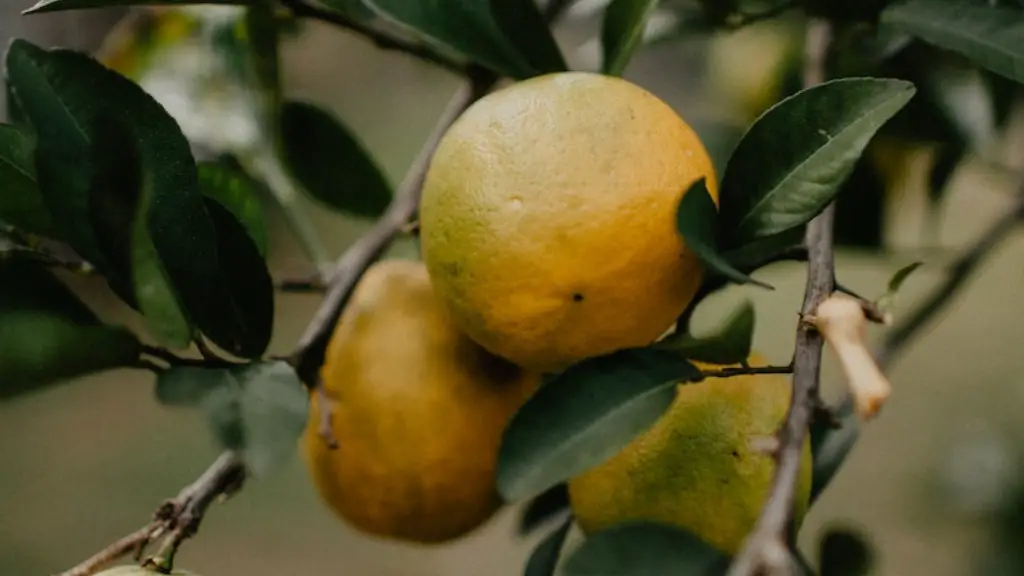Yellow leaves on a lemon tree can be a sign of a nutrient deficiency, environmental conditions or disease. The first step to treating a lemon tree with yellow leaves is to inspect it and identify the cause of the yellowing. Here are the steps to properly diagnose and treat a lemon tree with yellow leaves.
Evaluate the Tree’s Environment
Evaluating the environment of a lemon tree is the first step in determining the cause for yellow leaves. Look for indications of stress in the surrounding conditions. Lemon trees naturally grow in climates with mild temperatures and plenty of sunshine. If the tree isn’t receiving 6 to 8 hours of full sun daily, it may be time to consider relocating the tree. Trees in overly humid climates or locations exposed to wet conditions, like standing water, can be prone to disease which can be indicated by yellow leaves. Consider pruning and thinning the trees, as well as making sure it’s planted in soil with good drainage.
Observe Soil Conditions
Lemon trees thrive in well-draining soils that are slightly acidic. A pH test can help you determine if the soil is acidic enough for optimum growth. If the soil pH is too low, you may need to amend the soil with lime. Check the nutrient content of the soil using a soil test and supplement the soil, if needed. Adding fertilizers, especially with nitrogen, helps maintain adequate nutrient levels in the soil and promotes lush growth.
Check For Proper Watering
Lemon trees require frequent, even amounts of water to avoid dry soil conditions or forcing the tree to survive drought-like conditions. Regularly water a lemon tree, allowing the soil to dry slightly between each watering. Avoid overwatering and excessively wet soil, as it can cause yellowing leaves and lead to root rot.
Look For Diseases
Yellow leaves can sometimes be an indication of a disease or infestation. Common diseases and pests of lemon trees include aphids, mildew, root rot and leaf miners. If you spot any of these issues, take action to treat the tree immediately. Many of these pests and diseases are treatable, however, their symptoms need to be addressed immediately to ensure the health of the tree.
Analyze Plant Nutrition
Lemon trees need specific macronutrients to thrive. Provide your lemon tree with a well-rounded fertilizer at least once a year, including nitrogen, phosphorus and potassium. These macronutrients are essential for the tree’s growth, health and yield of lemons. A balanced fertilizer will promote growth and minimize the yellowing of leaves.
Identify Insect Damage
Insect damage can be mistaken for disease or nutrient deficiency and can cause yellowing of leaves. Monitor your lemon tree regularly and if you observe any suspicious infested branches, remove them and destroy them. Keep an eye out for aphids, which can feed on the lemon tree leaves and sap, leading to defoliation and yellowing of leaves.
Minimize Stress
Stress can cause yellowing of leaves. Avoid drastic pruning to a single branch, as this can damage the tree and make it vulnerable to disease. Do not move the tree from one place to another too frequently as this can disrupt its growth habit and slow down its development. Finally, limit excess fertilizer as this can disturb valuable nutrients that the tree needs.
Provide Proper Maintenance
Lemon trees require weekly maintenance to ensure their health and growth. Remove any dead or broken branches, as they provide entry points for pests and diseases. Prune the tree regularly to maintain its shape, encourage new growth and promote air circulation. Monitor the tree’s environment, such as its soil, water and sunlight, to ensure it’s receiving the right amount of all three. Finally, take steps to keep your lemon tree healthy and strong by providing essential nutrients and regularly checking for pests.
Regularly Inspect the Tree
The most important step in treating a lemon tree with yellow leaves is to regularly inspect the tree. Inspect the tree for signs of disease and stress. Monitor the soil to ensure the tree is receiving proper nutrients and water. Make sure the tree is receiving adequate sunlight and shade when necessary. Prune the tree and thin out dense foliage to promote air circulation and reduce the risk of disease. Regularly fertilize the tree and ensure the soil is slightly acidic. Take regular action to reduce stress, monitor for pests and keep the tree in a healthy and well-rounded environment.
Provide Pest Control
If yellow leaves are caused by pests, take steps to treat the tree immediately. Common pests of lemon trees include aphids, scale insects, leaf miners, and sooty mold. To control the pest infestation it’s important to identify the pest and determine an effective treatment plan. Be sure to apply safe pesticides and fertilizers, as they can be harmful if not used properly. Additionally, non-chemical remedies can be used, such as horticultural oils, insecticidal soaps, or natural bacteria and fungi.
Take Action Immediately
If your lemon tree is showing signs of yellowing leaves, take action immediately to prevent further damage. Identify the cause for the yellowing and take the necessary steps to address it. Inspect the tree for any signs of stress, disease, or nutrient deficiencies. If a pest infestation is the cause, take steps to identify the pest and properly apply a treatment. Monitor the environment of the tree, inspect the soil and provide necessary nutrients to promote healthy growth. Finally, regularly inspect the tree, prune its branches and take Preventative steps to reduce the risk of disease.


